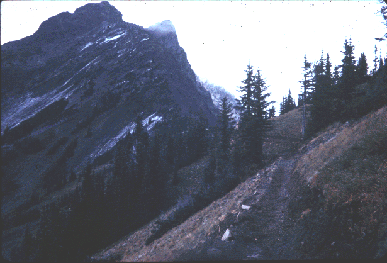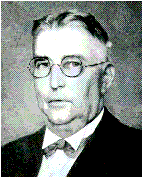A Retrospective History of the Pacific Crest Trail (PCT)
- Warren Lee (Cactus) Rogers

A brief history of the
Pacific Crest Trail
Prepared by Donald Lee Rogers
Revised March 21, 1997.

 The Pacific Crest Trailway System (PCTS) was originally discussed in several
parts of the country, during the very early 1900's.
A man by the name of Clinton C. Clarke heard of the idea during the
very early 1930's. Clarke liked the idea
of a ten (10)
mile wide pathway from Canada to Mexico for hikers and horsemen
to enjoy.
The Pacific Crest Trailway System (PCTS) was originally discussed in several
parts of the country, during the very early 1900's.
A man by the name of Clinton C. Clarke heard of the idea during the
very early 1930's. Clarke liked the idea
of a ten (10)
mile wide pathway from Canada to Mexico for hikers and horsemen
to enjoy.
 During 1932 Clarke, age 58, worked with the U.S. Forest Service
about establishing the PCTS.
He looked around for a means of publicizing the trail.
First he talked with the Boy Scout of America about a team relay of the trail.
They were very skeptical and turned him down. He then contacted the
Young Men's Christian Association (YMCA).
They also were very skeptical, but with much
insistence on Clarke's part agreed to participate.
During 1932 Clarke, age 58, worked with the U.S. Forest Service
about establishing the PCTS.
He looked around for a means of publicizing the trail.
First he talked with the Boy Scout of America about a team relay of the trail.
They were very skeptical and turned him down. He then contacted the
Young Men's Christian Association (YMCA).
They also were very skeptical, but with much
insistence on Clarke's part agreed to participate.
 Because of his association with the YMCA, Clarke was introduced to a
young man, age 24, by the name of Warren Lee Rogers.
Rogers had previously heard of the PCTS concept and was becoming an
avid PCTS explorer/hiker himself. Rogers agreed with almost everything
Clarke was purposing and became partners with the planning of the relays.
Because of his association with the YMCA, Clarke was introduced to a
young man, age 24, by the name of Warren Lee Rogers.
Rogers had previously heard of the PCTS concept and was becoming an
avid PCTS explorer/hiker himself. Rogers agreed with almost everything
Clarke was purposing and became partners with the planning of the relays.
 During 1932 Clarke and Rogers also established the Pacific Crest
Trail Systems Conference (PCTSC). Clarke became President and Rogers
the Executive Secretary to the conference. The PCTSC continued to promote
public use of the PCTS until Clarke's death in 1957, at the age of 84.
During 1932 Clarke and Rogers also established the Pacific Crest
Trail Systems Conference (PCTSC). Clarke became President and Rogers
the Executive Secretary to the conference. The PCTSC continued to promote
public use of the PCTS until Clarke's death in 1957, at the age of 84.
 During 1932, 1933, and 1934 the California Conservation Corps (CCC)
worked on establishing connector trails where needed. This was done in
conjunction with the U.S. Forest Service efforts to create a continuous
trail.
During 1932, 1933, and 1934 the California Conservation Corps (CCC)
worked on establishing connector trails where needed. This was done in
conjunction with the U.S. Forest Service efforts to create a continuous
trail.
 After the completion of the relays, which lasted the full summers of 1935,
1936, 1937, and 1938, Clarke and Rogers started out to make the PCTS
permanent and an everyday word for hikers the world over. Clarke, now 64,
depended on Rogers, age 30, for most field work.
Rogers and Clarke would work on various aspects of the trail, at Clarke's
Pasadena hotel, but Rogers was the one doing any actual
trail exploration/hiking.
Rogers lovingly referred to Clarke as the
Arm Chair Hiker. Although Clarke, it has just been recently verified,
was experienced in the outdoors, trips to Yosemite and the like, from the
Relays on Clarke never stepped foot on the PCT.
After the completion of the relays, which lasted the full summers of 1935,
1936, 1937, and 1938, Clarke and Rogers started out to make the PCTS
permanent and an everyday word for hikers the world over. Clarke, now 64,
depended on Rogers, age 30, for most field work.
Rogers and Clarke would work on various aspects of the trail, at Clarke's
Pasadena hotel, but Rogers was the one doing any actual
trail exploration/hiking.
Rogers lovingly referred to Clarke as the
Arm Chair Hiker. Although Clarke, it has just been recently verified,
was experienced in the outdoors, trips to Yosemite and the like, from the
Relays on Clarke never stepped foot on the PCT.
 Unfortunately, the PCTS immediately ran into problems. One of these was
World War II. With the government focused on the war effort,
some of the trails ran into disrepair.
Over the years non-government land was bought and sold. Since
the complete trail was never made permanent, by an act of Congress, it was
hard to maintain.
Unfortunately, the PCTS immediately ran into problems. One of these was
World War II. With the government focused on the war effort,
some of the trails ran into disrepair.
Over the years non-government land was bought and sold. Since
the complete trail was never made permanent, by an act of Congress, it was
hard to maintain.
 After Clarke's death, Rogers took over the monstrous effort of making
the PCTS permanent.
In February 1965, President Johnson took up Clarke's idea of a
"Trails for America",
of which the PCTS was to be included. During the next three years
Clarke's "Trails for America" concept changed into what was called
the National
Scenic Trails Act (NSTA). When the NSTA was finally passed
in 1968 the PCTS, which was now referred to as the PCT, became permanent.
However, very little money was allocated
to rework the now PCT and for obtaining permanent rights-of-way.
Over the next several
years many people worked to re-complete the PCT as close to its original
route as possible.
After Clarke's death, Rogers took over the monstrous effort of making
the PCTS permanent.
In February 1965, President Johnson took up Clarke's idea of a
"Trails for America",
of which the PCTS was to be included. During the next three years
Clarke's "Trails for America" concept changed into what was called
the National
Scenic Trails Act (NSTA). When the NSTA was finally passed
in 1968 the PCTS, which was now referred to as the PCT, became permanent.
However, very little money was allocated
to rework the now PCT and for obtaining permanent rights-of-way.
Over the next several
years many people worked to re-complete the PCT as close to its original
route as possible.
 Rogers' efforts continued to consume his total life until his death
on April 28, 1992. The Pacific Crest Trail Golden Spike Completion
Ceremony was held on the first National Trails Day, June 5, 1993.
Just over a year from Rogers' death.
Rogers' efforts continued to consume his total life until his death
on April 28, 1992. The Pacific Crest Trail Golden Spike Completion
Ceremony was held on the first National Trails Day, June 5, 1993.
Just over a year from Rogers' death.
One man's personal opinion:
 In historical retrospect, the team of Rogers and Clarke worked out to
be more than just life long friends. It turned out to be a tag team of
two men, one older and the other younger, whose love for
the PCT was able to span 60 years of continuous efforts. Clarke lead
the effort for 25 years with Rogers working at his side. Then Rogers
continued the task for the next 35 years.
In historical retrospect, the team of Rogers and Clarke worked out to
be more than just life long friends. It turned out to be a tag team of
two men, one older and the other younger, whose love for
the PCT was able to span 60 years of continuous efforts. Clarke lead
the effort for 25 years with Rogers working at his side. Then Rogers
continued the task for the next 35 years.
Warren Lee Rogers Clinton Churchill Clarke

 Two men - good friends - one trail - Rogers and Clarke.
Two men - good friends - one trail - Rogers and Clarke.
More will be added as quickly as possible.

Warren L. Rogers published a brief history of the original relays.
Copies available, E-mail for further infromation.

"THE PCT RELAYS"
"FIRST EXPLORATION"
Copyright  1968 Warren L. Rogers
1968 Warren L. Rogers
Library of Congress Catalog Card Number: 68-29616

 We are currently researching all documentation
about the Pacific Crest Trail to produce a historical book
covering all aspects of the early
development of the PCT.
We are currently researching all documentation
about the Pacific Crest Trail to produce a historical book
covering all aspects of the early
development of the PCT.
"A Cactus Grows On The Pacific Crest Trail - The Definitive History Of The PCT"
Copyright  1996 Donald L. Rogers
1996 Donald L. Rogers

Return to PCT's home page.

 The Pacific Crest Trailway System (PCTS) was originally discussed in several
parts of the country, during the very early 1900's.
A man by the name of Clinton C. Clarke heard of the idea during the
very early 1930's. Clarke liked the idea
of a ten (10)
mile wide pathway from Canada to Mexico for hikers and horsemen
to enjoy.
The Pacific Crest Trailway System (PCTS) was originally discussed in several
parts of the country, during the very early 1900's.
A man by the name of Clinton C. Clarke heard of the idea during the
very early 1930's. Clarke liked the idea
of a ten (10)
mile wide pathway from Canada to Mexico for hikers and horsemen
to enjoy.
 During 1932 Clarke, age 58, worked with the U.S. Forest Service
about establishing the PCTS.
He looked around for a means of publicizing the trail.
First he talked with the Boy Scout of America about a team relay of the trail.
They were very skeptical and turned him down. He then contacted the
Young Men's Christian Association (YMCA).
They also were very skeptical, but with much
insistence on Clarke's part agreed to participate.
During 1932 Clarke, age 58, worked with the U.S. Forest Service
about establishing the PCTS.
He looked around for a means of publicizing the trail.
First he talked with the Boy Scout of America about a team relay of the trail.
They were very skeptical and turned him down. He then contacted the
Young Men's Christian Association (YMCA).
They also were very skeptical, but with much
insistence on Clarke's part agreed to participate.
 Because of his association with the YMCA, Clarke was introduced to a
young man, age 24, by the name of Warren Lee Rogers.
Rogers had previously heard of the PCTS concept and was becoming an
avid PCTS explorer/hiker himself. Rogers agreed with almost everything
Clarke was purposing and became partners with the planning of the relays.
Because of his association with the YMCA, Clarke was introduced to a
young man, age 24, by the name of Warren Lee Rogers.
Rogers had previously heard of the PCTS concept and was becoming an
avid PCTS explorer/hiker himself. Rogers agreed with almost everything
Clarke was purposing and became partners with the planning of the relays.
 During 1932 Clarke and Rogers also established the Pacific Crest
Trail Systems Conference (PCTSC). Clarke became President and Rogers
the Executive Secretary to the conference. The PCTSC continued to promote
public use of the PCTS until Clarke's death in 1957, at the age of 84.
During 1932 Clarke and Rogers also established the Pacific Crest
Trail Systems Conference (PCTSC). Clarke became President and Rogers
the Executive Secretary to the conference. The PCTSC continued to promote
public use of the PCTS until Clarke's death in 1957, at the age of 84.
 During 1932, 1933, and 1934 the California Conservation Corps (CCC)
worked on establishing connector trails where needed. This was done in
conjunction with the U.S. Forest Service efforts to create a continuous
trail.
During 1932, 1933, and 1934 the California Conservation Corps (CCC)
worked on establishing connector trails where needed. This was done in
conjunction with the U.S. Forest Service efforts to create a continuous
trail.
 After the completion of the relays, which lasted the full summers of 1935,
1936, 1937, and 1938, Clarke and Rogers started out to make the PCTS
permanent and an everyday word for hikers the world over. Clarke, now 64,
depended on Rogers, age 30, for most field work.
Rogers and Clarke would work on various aspects of the trail, at Clarke's
Pasadena hotel, but Rogers was the one doing any actual
trail exploration/hiking.
Rogers lovingly referred to Clarke as the
Arm Chair Hiker. Although Clarke, it has just been recently verified,
was experienced in the outdoors, trips to Yosemite and the like, from the
Relays on Clarke never stepped foot on the PCT.
After the completion of the relays, which lasted the full summers of 1935,
1936, 1937, and 1938, Clarke and Rogers started out to make the PCTS
permanent and an everyday word for hikers the world over. Clarke, now 64,
depended on Rogers, age 30, for most field work.
Rogers and Clarke would work on various aspects of the trail, at Clarke's
Pasadena hotel, but Rogers was the one doing any actual
trail exploration/hiking.
Rogers lovingly referred to Clarke as the
Arm Chair Hiker. Although Clarke, it has just been recently verified,
was experienced in the outdoors, trips to Yosemite and the like, from the
Relays on Clarke never stepped foot on the PCT.
 Unfortunately, the PCTS immediately ran into problems. One of these was
World War II. With the government focused on the war effort,
some of the trails ran into disrepair.
Over the years non-government land was bought and sold. Since
the complete trail was never made permanent, by an act of Congress, it was
hard to maintain.
Unfortunately, the PCTS immediately ran into problems. One of these was
World War II. With the government focused on the war effort,
some of the trails ran into disrepair.
Over the years non-government land was bought and sold. Since
the complete trail was never made permanent, by an act of Congress, it was
hard to maintain.
 After Clarke's death, Rogers took over the monstrous effort of making
the PCTS permanent.
In February 1965, President Johnson took up Clarke's idea of a
"Trails for America",
of which the PCTS was to be included. During the next three years
Clarke's "Trails for America" concept changed into what was called
the National
Scenic Trails Act (NSTA). When the NSTA was finally passed
in 1968 the PCTS, which was now referred to as the PCT, became permanent.
However, very little money was allocated
to rework the now PCT and for obtaining permanent rights-of-way.
Over the next several
years many people worked to re-complete the PCT as close to its original
route as possible.
After Clarke's death, Rogers took over the monstrous effort of making
the PCTS permanent.
In February 1965, President Johnson took up Clarke's idea of a
"Trails for America",
of which the PCTS was to be included. During the next three years
Clarke's "Trails for America" concept changed into what was called
the National
Scenic Trails Act (NSTA). When the NSTA was finally passed
in 1968 the PCTS, which was now referred to as the PCT, became permanent.
However, very little money was allocated
to rework the now PCT and for obtaining permanent rights-of-way.
Over the next several
years many people worked to re-complete the PCT as close to its original
route as possible.
 Rogers' efforts continued to consume his total life until his death
on April 28, 1992. The Pacific Crest Trail Golden Spike Completion
Ceremony was held on the first National Trails Day, June 5, 1993.
Just over a year from Rogers' death.
Rogers' efforts continued to consume his total life until his death
on April 28, 1992. The Pacific Crest Trail Golden Spike Completion
Ceremony was held on the first National Trails Day, June 5, 1993.
Just over a year from Rogers' death.




 1968 Warren L. Rogers
1968 Warren L. Rogers